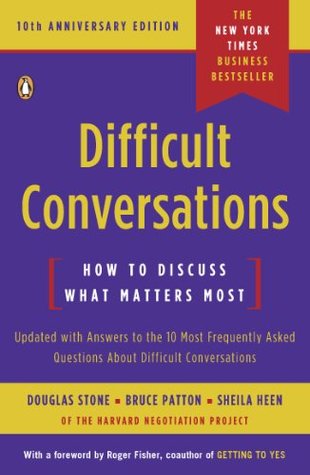More on this book
Community
Kindle Notes & Highlights
Read between
February 5, 2021 - October 18, 2024
Reframe, reframe, reframe to keep on track. From truth to perceptions, blame to contribution, accusations to feelings, and so on.
My identity conversation keeps getting stuck in either-or: I’m perfect or I’m horrible. I can’t seem to get past that. What can I do?
The big three blind spots are tone of voice, facial expressions, and body language.
instead ask what if it were true? What would it mean? What would be the implications for you?”
As we know, one reason people argue about what happened is that the other person’s view threatens their identity. This approach addresses that interest directly, perhaps allowing Peter to help Lucera find a way to feel less threatened by the prospect of learning that her behavior has had unintended consequences.
“What are you concerned might happen if we go in this direction?”
Often when someone resists acknowledging their contribution to a situation, it’s because to do so would threaten their identity.
For many of us, the concepts of multiple valid perspectives, joint contribution, contribution without blame, and identity without perfection may be novel. It may take them a while to understand these ideas and get comfortable with them. Don’t give up too easily or be surprised if change comes haltingly over time.
Influence is the ability to affect someone else’s thinking.
“Let’s talk about the Vancouver Project. It was three days late. Let’s figure out why, assess the impact, and decide how to avoid this going forward.”
Ultimately it is the combination of assertiveness and inquiry that helps us pool our insights, learn things we didn’t know, and lay the foundation for creative and effective problem-solving.
We emphasize listening here because the far more common mistake in conversation is failure to listen rather than failure to assert. When
So it’s easy to view our encouragement to raise things directly, rather than avoiding and letting them fester, as simply part and parcel of our immersion in American culture.
It’s all a question of the appropriate time, place, and mode of expression.
“You may be right, and I may well be missing something (it wouldn’t be the first time), and yet so far I don’t see it.”
Being able to talk about the unintended impacts we’re having on one another becomes critical to maintaining good working relationships.
Seeing our own contribution to the confusion or frustration, and getting curious about why
use it wisely and avoid its tendency to escalate conflict.
Many people use e-mail to initiate hard conversations they don’t have the courage to confront in person.
E-mail isn’t dialogue — it’s serial monologue. There’s no opportunity to interrupt for clarification, to see the other’s reaction and correct course, or to test our assumptions about their intentions before locking into interpretations and emotional reactions.
You can’t resolve an e-mail conflict with e-mail.
Anything you write during a conflict can be taken the wrong way.
Being clear about your purposes, reasoning, and feelings can help ward off misunderstanding,
In the meantime the person waiting for the answer is left to interpret the silence, wondering, “Why aren’t they answering me?”
Clear up the ambiguity before you fire off a shot that further escalates the exchange.
Given the monologue nature of e-mail,
Taking seriously the possibility that there’s something important you don’t know and showing genuine openness to their thinking makes it easier for them to share their internal voice and help correct misunderstandings or missed assumptions earlier rather than later.
We often translate feelings into arguments, accusations,
Finally, how you raise the matter of feelings is critical. Talking about emotions by being emotional — crying, screaming, pouting, eye-rolling, or foot stomping — will often make you appear weak, out-of-control, or unprofessional.[*]
Friends and colleagues can help us appreciate the other side’s perspective, understand our own contribution, and think about the other side’s intentions or the identity issues that are making us overreact.
The earlier you raise an issue, catch a misunderstanding, or ask a question to clarify intentions, the sooner you clear it up and move on. The longer you let things fester, the bigger the problem becomes.
the more skillful you can be about how you raise and discuss something, the more effective and efficient the conversation is likely to be.
has come to see that this behavior is rooted in the belief that a good and valued person doesn’t disappoint people or let them down. He worries that if he does let someone down, he’ll be rejected, or even disowned.
To avoid feeling intolerable guilt or shame, Antonio determines, at least in the moment, that the criticism must be wrong or ill-intended. Now angry, he tries to show that the situation was actually the result of mistakes other people made, particularly the person raising the concerns.
he can’t see what’s happening when it’s happening, or think what else to do.
he hasn’t really found a way to accept himself as someone who could disappoint others. There are several things one can do to help with that kind of challenge.
school psychologist that gifted children who are given too much praise can get the message that they are only loved for their achievements.”
Working your way through difficult conversations is hard and often discouraging work — especially when you’re not seeing your openness reciprocated or your willingness to be accountable for your contributions appreciated.
If someone is unwilling to examine their own contribution to a problem or take responsibility for the impacts of their actions, you can’t force them to.
All you can do is take a hard look at yourself, be open to seeing things differently, change your own contribution, and be honest about what matters to you.
Giving up requires you to have a difficult conversation with yourself about making a healthy choice — for yourself and those you love — and to be able to forgive yourself.


